Mark Todd's Blog, page 13
April 20, 2013
An interview with fictioneer Teresa Milbrodt
 [This is part of our monthly series of guest posters.]
[This is part of our monthly series of guest posters.]We wanted to talk directly to Teresa Milbrodt about her stories and books. She’s writes magical realism, fantasy, and just plain weird fiction. She has three large mailbags full of rejection letters she’s collected over the past 10 years, but that’s okay. It gives her a bit of a vantage point – a throne, if you will – to gloat over the fact she now publishes four to six stories in major lit journals every year.
And with two books under her belt and two more forthcoming next year, she’s a force unto herself!
But we’re concerned all these fantastic plots and characters may be unhinging her a bit, and so we decided to get to the source:
An interview with “Cyclops,” one of Teresa Milbrodt’s fictional characters
Kym-n-Mark: We want to thank you for agreeing to talk to us secretly.
Cyclops: Yeah, whatever.
Kym-n-Mark: Uh, okay. Well, if this intervention for Teresa is going to work, we need to understand why she’s teetering on the edge of so much … weirdness. There’s just no other way to put it.
Cyclops: Tell me about it.
Kym-n-Mark: And we know you are major character in her new novel, The Patron Saint of Unattractive People. We think you may be essential in helping her reconnect with reality. So, Cyclops, tell us why you think she spends so much time in your head. Or is it the other way around?
Cyclops: Talk about needing to reconnect with reality! I mean, she’s an okay writer and all, but she couldn’t make a decent espresso to save her life. What business does she have writing about coffee shops
and baristas if she’s never made a double-shot mocha? You can’t write about working in the trenches if you’ve never been in them, I say. And she gave me absolutely no love life for the better part of thirty-seven years. I mean really, doesn’t she think I’d like to get out from time to time and have a little fun? Just because she’s a crazy workaholic doesn’t mean I have to be one, too. At least she didn’t make me a vegetarian. God, that would have been awful...
Kym-n-Mark: Okay, okay, we get it. But back on topic, how would you suggest –
Cyclops: She also let my mom take up smoking again, and I don’t know if I can forgive her for that one. Have you seen those lung tissue samples that they have on display in science museums, you know, in those exhibits about the dangers of tobacco? Disgusting, but then my mom has to go back to her half-pack-a-day habit thanks to my dad stressing her out. Why couldn’t she send them to a good marriage counselor rather than letting my mom get back to old habits? She’s tried to tell me a bunch of B.S. about the cigarettes being good for plot and tension because it pissed Dad off as much as it pissed me off, but
really, this is my mom’s life we’re talking about. I’m sure she wouldn’t like it if I made her mom take up smoking.
Kym-n-Mark: Er, Cyclops, we really wanted to talk about Teresa and her problems with reality.
Cyclops: She didn’t even let me have a proper name. I’m just the cyclops woman throughout the entire book, and what’s up with that? But I guess she gave me a cool record collection. That’s one nice thing I can say about her. Get back to me in a while, and I might have come up with something else.
Kym-n-Mark: Uh, yeah, maybe we will. And we’ll let you know how the intervention works out.
+ + + + + + + + +
The Patron Saint of Unattractive People is forthcoming in September, 2013, from Boxfire Press.
In the meantime, check out her backstory at her Website, where you can read some of her selected published and unpublished stories, excerpts from forthcoming works, and deleted scenes from various projects.
Be sure to check out these video clips of Teresa reading from her "Larissa" alter-ego series (the short story collection is forthcoming next year!)
(Thanks, Teresa, for playing along!)
All gestes aside, we invite you to comment or visit with Teresa. She – or one of her fictional alter-egos – are bound to answer!
Published on April 20, 2013 14:25
An interview with fictioneer Teresa Mildrodt
 [This is part of our monthly series of guest posters.]
[This is part of our monthly series of guest posters.]We wanted to talk directly to Teresa Milbrodt about her stories and books. She’s writes magical realism, fantasy, and just plain weird fiction. She has three large mailbags full of rejection letters she’s collected over the past 10 years, but that’s okay. It gives her a bit of a vantage point – a throne, if you will – to gloat over the fact she now publishes four to six stories in major lit journals every year.
And with two books under her belt and two more forthcoming next year, she’s a force unto herself!
But we’re concerned all these fantastic plots and characters may be unhinging her a bit, and so we decided to get to the source:
An interview with “Cyclops,” one of Teresa Milbrodt’s fictional characters
Kym-n-Mark: We want to thank you for agreeing to talk to us secretly.
Cyclops: Yeah, whatever.
Kym-n-Mark: Uh, okay. Well, if this intervention for Teresa is going to work, we need to understand why she’s teetering on the edge of so much … weirdness. There’s just no other way to put it.
Cyclops: Tell me about it.
Kym-n-Mark: And we know you are major character in her new novel, The Patron Saint of Unattractive People. We think you may be essential in helping her reconnect with reality. So, Cyclops, tell us why you think she spends so much time in your head. Or is it the other way around?
Cyclops: Talk about needing to reconnect with reality! I mean, she’s an okay writer and all, but she couldn’t make a decent espresso to save her life. What business does she have writing about coffee shops
and baristas if she’s never made a double-shot mocha? You can’t write about working in the trenches if you’ve never been in them, I say. And she gave me absolutely no love life for the better part of thirty-seven years. I mean really, doesn’t she think I’d like to get out from time to time and have a little fun? Just because she’s a crazy workaholic doesn’t mean I have to be one, too. At least she didn’t make me a vegetarian. God, that would have been awful...
Kym-n-Mark: Okay, okay, we get it. But back on topic, how would you suggest –
Cyclops: She also let my mom take up smoking again, and I don’t know if I can forgive her for that one. Have you seen those lung tissue samples that they have on display in science museums, you know, in those exhibits about the dangers of tobacco? Disgusting, but then my mom has to go back to her half-pack-a-day habit thanks to my dad stressing her out. Why couldn’t she send them to a good marriage counselor rather than letting my mom get back to old habits? She’s tried to tell me a bunch of B.S. about the cigarettes being good for plot and tension because it pissed Dad off as much as it pissed me off, but
really, this is my mom’s life we’re talking about. I’m sure she wouldn’t like it if I made her mom take up smoking.
Kym-n-Mark: Er, Cyclops, we really wanted to talk about Teresa and her problems with reality.
Cyclops: She didn’t even let me have a proper name. I’m just the cyclops woman throughout the entire book, and what’s up with that? But I guess she gave me a cool record collection. That’s one nice thing I can say about her. Get back to me in a while, and I might have come up with something else.
Kym-n-Mark: Uh, yeah, maybe we will. And we’ll let you know how the intervention works out.
+ + + + + + + + +
The Patron Saint of Unattractive People is forthcoming in September, 2013, from Boxfire Press.
In the meantime, check out her backstory at her Website, where you can read some of her selected published and unpublished stories, excerpts from forthcoming works, and deleted scenes from various projects.
Be sure to check out these video clips of Teresa reading from her "Larissa" alter-ego series (the short story collection is forthcoming next year!)
(Thanks, Teresa, for playing along!)
All gestes aside, we invite you to comment or visit with Teresa. She – or one of her fictional alter-egos – are bound to answer!
Published on April 20, 2013 14:25
April 14, 2013
Backing into the YA Market
 We always figured our writing was for our own amusement. Sure, we hoped to see our novels in print, but the real purpose of the projects was about writing together, having fun, and putting characters into impossible situations.
We always figured our writing was for our own amusement. Sure, we hoped to see our novels in print, but the real purpose of the projects was about writing together, having fun, and putting characters into impossible situations.Plus we never fail to become amused at ourselves when we write. If anyone else thinks our stories are entertaining, that’s pure gravy (hm, maybe even groovy).
What we never expected was how popular our first Silverville Saga story, The Silverville Swindle, would become among young adults. That wasn’t the market we targeted, and the novel certainly didn’t fit any of the standard tropes for the genre. Our main characters were all thirtysomethings, and the situation hardly concerned coming-of-age themes.
 But before we knew it, one courageous school librarian had suggested the book to her students, and it soon
But before we knew it, one courageous school librarian had suggested the book to her students, and it soon found its way into a several school libraries based on the logline (“What if a small town tried to cash in on a local UFO sighting?”) In six month’s time, students across the state had nominated it for the Colorado Blue Spruce Award for Young Adult Fiction. Other librarians took notice, and the book went into a slew of public libraries in the region. When we later started shopping around the sequel, editors and agents scratched their heads and told us the success in that market was a fluke. The story just didn’t fit the model.
But when Raspberry Creek Books took a chance on us, the second novel in the series, All Plucked Up, received a nomination for the Colorado Book Award in YA Fiction. And we still thought we were writing for adults. Maybe our humor is juvenile – or maybe it’s universal (we hope).
We’re finally learning to embrace the market’s found us, and the forthcoming third book in the series, The Magicke Outhouse (no potty humor intended – well, perhaps just a little), features a couple of characters that fit YA genre expectations. But the story’s still not about capturing younger readers.
That first novel in the series were through several editions, even landing on the Washington Center for the Book’s recommended reading list at the Library of Congress. Now, as we see Silverville Saga, Book One reincarnated into Little Greed Men, we hope it finds a new audience – one that likes to laugh.
 Still, most of all we’re just trying to have fun, amusing ourselves along the way. Of course, we hope others find our humor entertaining – even adults.
Still, most of all we’re just trying to have fun, amusing ourselves along the way. Of course, we hope others find our humor entertaining – even adults.And having an audience find us is still just gravy.
Which is also groovy.
Published on April 14, 2013 22:12
April 10, 2013
Countdown for Little Greed Men's release is on!
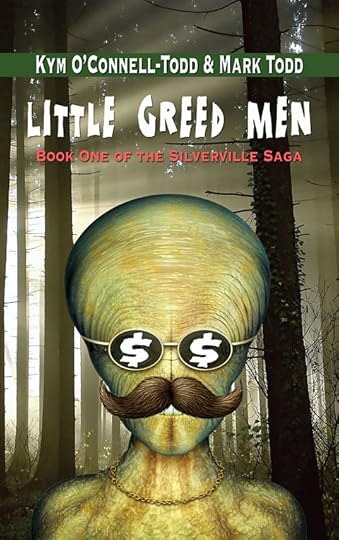 Our new publisher for the Silverville Saga series, Raspberry Creek Books, has sent Little Greed Men to the printers, so the countdown is on for street release at the end of April.
Our new publisher for the Silverville Saga series, Raspberry Creek Books, has sent Little Greed Men to the printers, so the countdown is on for street release at the end of April.Stay tuned for sneak-peeks about the book in coming days.
In the meantime, be sure to sign up for the Goodreads Giveaway.
And check our Goodreads author pages and Amazon author pages for upcoming readings and other promos to celebrate Books One and Two of this paranormal comedy-adventure. (Book Three on the way at the end of the year or early next year!)
Published on April 10, 2013 22:31
April 2, 2013
Death by (over)outlining
 Picture this: You, sitting at your keyboard. It’s day 100 of writing your first book. You’ve drained the coffeepot once again, considered breaking into the brandy, and now you’ve discovered a little bald spot where you’ve torn your hair out. Where’s the book going?
Picture this: You, sitting at your keyboard. It’s day 100 of writing your first book. You’ve drained the coffeepot once again, considered breaking into the brandy, and now you’ve discovered a little bald spot where you’ve torn your hair out. Where’s the book going? Maybe nowhere, unless you have a plan, a roadmap, an outline.
We’ve talked to writers who actually avoid this detail. They have a vague notion of their yarn and they’re anxious to start writing, not spin their wheels on this organizational modus operandi. But for some writers (and we’re probably not the only ones) drafting an outline is the most efficient way to advance the story without the show-stopper of “what comes next.”
For us, it makes sense. Once we have an overall notion of our book’s beginning, middle and end, we fill in the gaps with chapter road signs that move the story forward. But we didn’t figure it out right away. After multiple attempts at outlining techniques (more on one of those fiascos in a minute), we finally discovered the “less is more” approach gives us wiggle room for changes.
Example: Chapter Six of The Magic Outhouse: Buford decides to turn his time machine into a business.
Okay, not much to go on for an entire chapter. But if you’re already at chapter six, you know your novel has the capacity to take on a life of its own. The evolution of story starts the moment you develop your first characters, and they may have better ideas than you about where the tale should go. By not getting too specific on your roadmap, you’re free to take as many detours as you want.
So Buford decides to start the business. But maybe by chapter five he’s picked up a new partner, or he’s wound up in jail and can’t find the financing.
Each chapter nugget (if it still even fits) of the outline will need a few bullet points. If Buford isn’tin jail, he might look for a business location, interview new employees and implement everything else involved in starting a new venture. Now you’re in the driver’s seat and can start collaborating with your characters without sacrificing additional hair.
One of our earlier fiascos (as promised) involved drafting an outline for a historical fiction novel on ancient Egypt. We spent months researching the topic – years actually, if you count the time we spent trying to learn hieroglyphs. Once we felt pretty good about our expertise, we jumped into the outline. And what a thorough outline it was. Each of the twenty chapters turned into a page or more of precise details. When we finally began the book, we slogged through about three or four scenes before we became utterly bored with the story. We’d left no wiggle room to invent or improvise, no opportunity for our characters to evolve and no chance to discover fresh turning points in the story. The outline had so shackled us to its rigid constraints, we decided to ditch the project altogether.
For us, the bare-bones outline works. We write chapter "loglines" for where the story might go, but we only flesh out the immediate chapter ahead with a paragraph to focus our attention on the next five to ten pages. That way, we avoid planning out in detail where we may – or may not – be headed.
You be the judge of how intricate your roadmap should be, and how you embark on your initial journey. Otherwise, you might as well start shopping for a jaunty hairpiece.
* * *
So much for our strategy. We’d love to hear how other folks approach their projects.
Published on April 02, 2013 12:07
March 27, 2013
Guest Blog: Lights! Camera! Story!
 Kym-n-Mark are excited to share with you the thoughts of our good friend, Alan Wartes,
Kym-n-Mark are excited to share with you the thoughts of our good friend, Alan Wartes, independent filmmaker and videographer.
Alan describes himself as a writer, musician, filmmaker, and urban farmer who lives in Denver with his wife, the incomparable Issa Forrest, and an assortment of children, grandchildren, goats, and chickens.
But Alan is also a poet and stage performer -- fearless and successful in so many media.
(Be sure to check out the video clips interspersed through his wonderful insights below not only into writing for film but also making that film yourself!)
+ + + + +
After mulling many different ideas to share with the virtual writer’s community being lovingly assembled here by Mark and Kym, I finally realized that I’m not ready to quit the conversation they began in last week’s blog: “How (Not) to Write a Screenplay.” So at the risk of using my turn at the wheel to steer the site (again) toward screenwriting—and offending those who see it as the novel’s red-headed step-sister—I’d like to share a few insights earned in one of the best (and most terrifying) writing schools known to (this) man: producing and directing my own scripts.
The timing couldn’t be better, really, since I am presently neck deep in production on a new short film called “The Edge,” so the issues are not merely theoretical in any way. As we used to say when I was in the army, there are two kinds of solution to any problem: book solutions and field solutions. In other words, what you think you know in the classroom isn’t worth diddly squat until it has survived a day in the real world where people are shooting at you and saying mean things with a lot of feeling. Or, in the case of filmmaking, where Murphy’s Law was actually written and beta tested before its release to the general public. Imagine planning three weddings every day for a week—for $50 each—and you’ll start to understand the joys of indie filmmaking.
Fast Food Romeo—2006.
High school science geek Joe Morris makes the most of his strengths and talks to the girl of his dreams on his own terms—by hacking her drive-up window headset at the fast food joint where she works.
Ah, but it is joyful, and none of that other stuff matters much—when you’ve got a story to tell that is burning holes in your eyelids. But, of course, that describes a lot of people. The trick is knowing how to tell it well. Notice I did not say that the trick is knowing how to sellit well. It is way too easy to forget that we are storytellers, after all. Storytellers do far more than string clever words together like cheap beads for sale on blankets at the flea market. We create worlds and populate them with people who look to us like Greek gods to make their lives mean something, for pity’s sake! “Why have you forsaken us in Act Two? Is there any hope that will come back for us before The End?” It is an awesome responsibility.
Okay, three lessons I’ve learned about writing in general by daring to write screenplays and then make the movies myself, saying to Hollywood, “Be gone! I don’t believe in you!” Never fear. If you have no intention of ever doing any such thing, these tidbits might help you along with whatever form of writing is burning holes in your eyelids.
1. Write what you can actually shoot. I had to chuckle at the advice Mark and Kym received from their film industry friend, something like: “Are you crazy? You set your story on a Texas beach during a hurricane with five hundred oil rigs burning offshore?” Could be one hell of a yarn, but…only Bruce Willis could sell it. I am paying (literally) for this mistake myself next weekend when we will shoot the “bar scene” in “The Edge” which calls for 20 extras on top of the rest of the cast. Sounded great until I remembered that I have to feed them all lunch.
But here’s the point: When you sit down to write, remember that life is rarely lived on an epic scale. Once in a while you happen to be sitting on the beach when a tsunami strikes, but mostly we live in small, ordinary moments that don’t look like much, but which reveal who we are, what we want, and what obstacles we are willing to overcome to get it. In other words, the locations and situations close to home are where the stories are. I Once Ate a Pepper—2012
A super-fun animated short about the perils of eating a pepper “right off the vine.” Be sure to watch to the very end.
2. Screenplays aren’t finished art—movies are. When is the last time you saw a screenplay on the NYT bestseller list? On the front table at Barnes and Noble? For that matter, when’s the last time you actually read one? Anyone? Now, when’s the last time you saw a great movie?
Hot tip: The words in a screenplay are there for one reason—as a blueprint to help filmmakers paint with light and bring the story to life. That’s why formatting and convention matter so much; mostly to help the writer get out of the way and let the imagery and dialogue speak for itself. Hot tip corollary: All words, in any written medium, are there to create magic images in the mind of the reader. Too much cleverness, too much of the sound of your own voice is a bad thing.
3. Write dialogue that real actors actually want to say. Poets must read their words out loud. Ditto novelists once in a while at book signings. But as a screenwriter making my own movies, I must endure the “read through”—a real come-to-Jesus moment when other peopleembody my characters and say out loud the words I gave them—in a medium that will last a long time. Nothing will reveal the trite, the wooden, the unmotivated, the petty, the crass, the just plain bad any faster. Here’s how to avoid that: Write with love, deep, deep love for your characters—even the bastards who, after all, are only doing what they think they must to survive. Treat them with dignity, honor, integrity, and above all, compassion—like they are children rescued from a shipwreck. Do that and they will never embarrass you.
You want to write a screenplay? Read the how-to books, take a seminar, get lots of advice. But never forget your story—and storytelling—in the process. Finally, once you’ve written it—pick up a camera and just make the damn thing!
+ + + + +Thanks, Alan, for sharing your creative spirit with us!
Also be sure to check out Alan's music:
Avalon Road
A Denver acoustic band playing Alan’s original music. Members: Alan Wartes, Issa Forrest, Eric Moon, Lia Davis, and Monika Vischer. http://www.myspace.com/avalonroadmusic/music+ + + + +
Published on March 27, 2013 17:19
March 19, 2013
How (Not) to Write a Screenplay
 Hollywood’s expectation for spec writers is straight forward – if you’re walking backwards. What studio folks want to hear is a fresh and original story idea that sounds like something they’ve already heard.
Hollywood’s expectation for spec writers is straight forward – if you’re walking backwards. What studio folks want to hear is a fresh and original story idea that sounds like something they’ve already heard. We found that out the hard way.
After we’d written the first book in our paranormal adventure-comedy series, the Silverville Saga, lots of readers told us it should be a movie, and we believed them. So we tried writing our very own screen adaptation.
Mistake No. 1 – We didn’t know what we were doing.
We took our novel and chopped out all the exposition and reformatted the remaining dialog with a bit of action to contextualize what characters – er, we mean, actors – would say. Our script was more of a stage play with no stage, and it was awful.
A couple of screenwriting friends advised us to attend a few workshops (we attended), buy a few books on the subject (we bought), and try again (yep, we tried).
Mistake No. 2 – We didn’t buy Save the Cat.
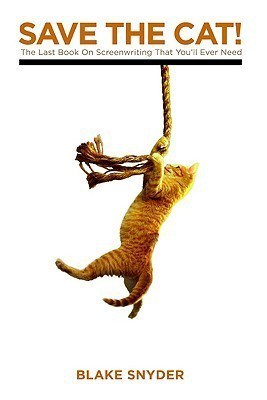 This time we had a couple of Indy directors and a fairly big producer look us over. But no meetings – at least, none that led to movie deals. One good friend and mentor, a longtime Hollywood stuntman and stunt double for the likes of Clark Gable, John Wayne and, well, you name it and he stood in – so, this friend read our script and told us we still didn’t know what we were doing. He tapped page fifteen and pointed to a description we’d included, telling us, “That one little sentence is going to cost $10,000 in production values. Any script reader would see that and tell the producer to pass on your property. Go back and do your homework.”
This time we had a couple of Indy directors and a fairly big producer look us over. But no meetings – at least, none that led to movie deals. One good friend and mentor, a longtime Hollywood stuntman and stunt double for the likes of Clark Gable, John Wayne and, well, you name it and he stood in – so, this friend read our script and told us we still didn’t know what we were doing. He tapped page fifteen and pointed to a description we’d included, telling us, “That one little sentence is going to cost $10,000 in production values. Any script reader would see that and tell the producer to pass on your property. Go back and do your homework.”Mistake No. 3 – We bought the right book, but we didn’t follow the advice.
Yes, Snyder’s advice is formulaic, and yes it’s restrictive. But it works. It’s what moviemakers want; it’s also what moviegoers expect. Like any seasoned writing professional knows, you have to write to the medium. Screenplays are a specialized medium, and you’ve got to craft the words to play to the strengths. Formula and tight structure are two of those strengths.
Even though this new approach to writing hurtled our words down a narrow corridor that felt like a giant water slide, the payoff was getting to focus on the important scenes (let prose writers chop through the dense foliage of exposition). It was fun, and it made us rethink our novels as well. Shouldn't all our scenes be important? Do we really want ferns and vines obscuring so much of the straight shot through our water slides? Okay, different medium, but there was a valuable take-away from Snyder's advice, regardless of medium. After all, the name of the game is still storytelling.
Snyder’s book explains all that and more, plus he also gives value-added advice that opens windows into the weird world of movie making and movie deals. It’s not enough to have a good story – maybe not enough to have a good script.
Just like good dialog in any medium, it’s all about the subtext. Snyder provides that subtext, explaining to aspiring screenwriters how the process works both on and off the page, both in front of the camera and around the boardroom, both within the studio system as well as throughout the whole, weird tinsel-twisted town.
In the end, we took away three things from our screenwriting experience: We love writing that focuses all the attention on scenes that matter. Screenwriting strategies can make any story tighter and, frankly, better because it’s good craft that makes good stories come to life. We’re not yet competent screenwriters.
Mistake No. 4 –
We’re still waiting to make that one. We don’t know what it is or when it’s coming; of course, we’re sure the answer on how to avoid it lies somewhere in the pages of Save the Cat. And we’re sure someone will point out the passage as soon as we make inevitable Mistake No. 4.
The process almost feels reassuring, kind of like walking straight forward.
Only backwards
-- Kym-n-Mark
+ + + + +Progressive Book Club: A meeting of the minds, open each month to those who wish to read and discuss the current book with their peers. Join in on the titles you like, pass on those you don’t. It’s that simple.
Now it's time to join the next PBC blog discussion on Save the Cat:

1. M.L. Swift, Writer

2. A Thought Grows

3. Ink in the Book

4. Pennies in the Jetstream

5. J. Keller Ford, Author

6. Eureka Wrote

7. Sydney Aaliyah

8. Angler's Rest

9. Dream...Write...Publish

10. Tara Tyler Talks

11. Tyrean's Writing Spot

12. The Ninja Librarian

13. Melissa Maygrove

14. Lynda R Young

15. Write in the Thick of Things
Published on March 19, 2013 11:08
March 12, 2013
Wormhole Blog Hop
(Lieber Albert, Fröliches Geburtstag!)
 Our wormhole plugs into the many-worlds multiverse, where any variation on a world you can imagine exists somewhere out there.
Our wormhole plugs into the many-worlds multiverse, where any variation on a world you can imagine exists somewhere out there.  When we learned to read Ancient Egyptian hieroglyphs (nerd alert), we became fascinated with that time period, but we’d visit a version with three improvements. Our wormed version of that world would have indoor plumbingair conditioning chocolatePlus Kym wants to wear the skimpy clothes, Mark wants to drive a chariot, and both of us want the chance to smite our enemies.
When we learned to read Ancient Egyptian hieroglyphs (nerd alert), we became fascinated with that time period, but we’d visit a version with three improvements. Our wormed version of that world would have indoor plumbingair conditioning chocolatePlus Kym wants to wear the skimpy clothes, Mark wants to drive a chariot, and both of us want the chance to smite our enemies.(Notice we avoided the paranormal adventure-comedy world of our own Silverville Saga series – we already live there.)
This is a Blog Hop! Proceed to the next wormhole from the list below:
1. Laura Eno2. Breakthrough Blogs3. LG Smith Bards and Prophets 4. Scribbles From Jenn5. Writers Mark6. C. M. Brown 7. Ninja Captain Alex J. Cavanaugh8. Tyreans Writing Spot9. mainewords 10. M. J. Joachims Writing Tips11. magpiewrites12. Isis Rushdan 13. Lex at Pennies14. Nancy S. Thompson15. The Writing Nut 16. Samantha May: Writing Through College17. stuart sharp18. I Think; Therefore, I Yam 19. Sandy Sanderellas Musings For Day To Day Blogging20. Julie Flanders21. Father Dragon Writes 22. Jemi Fraser23. Mary Pax24. Jamie Ayres 25. The Eagles Aerial Perspective26. Nicki Elson27. they say everyone has a story 28. Tangent Shell29. Trisha @ WORD+STUFF30. Maryann Millers Its Not All gravy 31. We Are Adventure32. Livia Peterson: Leave it to Livia33. austanspace 34. tammy theriault35. Medeia Sharif36. Tina @ Life is Good 37. One Magic Bean Buyer38. Sydney Aaliyah Michelle39. Karen Elizabeth Brown 40. Meradeths Write Stuff41. Michelle @ Writer~In~Transit42. Aristotles Mistake 43. Writers Block44. Writing Off the Edge45. Reading, Writing and Everything In Between 46. In Between - Adriana Dascalu47. Ellie Garratt48. Swagger Writers 49. Michael @ In Time . . . 50. Kidbits51. Write in the Thick of Things 52. DG Hudson - Rainforest Writing53. Adventures in Rehab (Id go backwards to mis this)54. WTFs - Writing Thrilling Fiction 55. Vanessa Morgan56. Avalon57. J. A. Bennett, A Writers Journey 58. Damyanti@ Amlokiblogs59. So I Was Thinking. . . 60. Confessions of a Watery Tart 61. Mark Noce Stories62. Travelling Cats
Published on March 12, 2013 21:14
And the winning cover for the new Silverville Saga book is ...
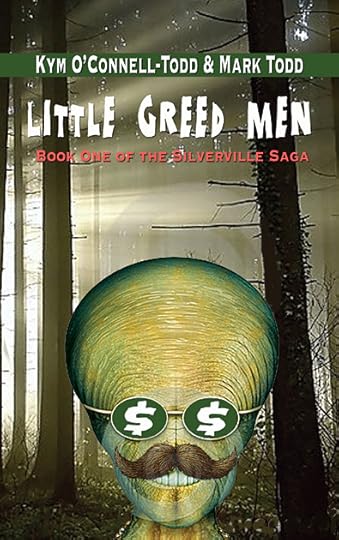 ... by overwhelming popular acclaim the "Out of the Woods" design.
... by overwhelming popular acclaim the "Out of the Woods" design.We hear you, and publisher Raspberry Creek Books has agreed to use that cover for the release of Little Greed Men early this spring.
Here's the premise from the back cover blurb:
What happens when a town's local resident spots a UFO?
Silverville sees nothing but dollar signs.
First an amusement park and museum, then a celestial motif for the whole town. Con artists and embezzlers, tourists and kooks, all get caught up in the frenzy, some hoping to make a quick buck, others seeking a spiritual message from beyond the stars.
Ride along on this irreverent adventure that reveals Colorado mountain culture at its most outrageous, and where just about everybody shares in the madness of money, murder, and mayhem.
Publication back story:
This is a re-release in affordable paperback as well as e-reader format of a book that first came out several years ago under the title of The Silverville Swindle. But at the time we thought of the novel as a one-off, not Book One of a paranormal adventure-comedy series that now includes a planned four books -- the second, All Plucked Up (released this past December); the third, The Magicke Outhouse (forthcoming at the end of the year); and an untitled fourth in development for the following year.
Recognition:
Soon after publication, the original edition garnered several nods, including a nomination for the Colorado Blue Spruce Award for Young Adult Fiction as well as a following among high school students and YA readers spanning many borders. (This always puzzled us -- although delighted by this reception, we didn't particularly write the novel for that audience, and our story breaks many of the "rules of engagement" with that readership.)
Next, the Washington Center for the Book placed the title on the recommended reading list at the Library of Congress.
Praise:
I loved this book. It's trite to say I couldn't put it down, but that's the truth. Even more, I'm looking forward to the next book by the Todds. Great plot development, and they nailed the characters and the setting. It's hard to believe this is a first novel. This is a thoroughly enjoyable and entertaining book filled with humor, intrigue, and likeable, memorable characters. It starts at an attention-snagging pace and grows throughout. A delicious romp through a tight adventure.– W.C. Jameson, History Channel commentator and author of over sixty books about the West, more recently the novel Beating the Devil and the biography Billy the Kid: Beyond the Grave
Any reader in the West will recognize Silverville with a knowing grin – and often enough, a knowing shudder. The Todds have written a funny book about a townful of people we’d just as soon know from a literary distance but suspect we might live next door to – or maybe even closer…. This book about close encounters of every kind is further evidence that any search for intelligent life in the universe might not stop very long at our planet.– George Sibley, New York Times best-selling author of Part of a Winter, Dragons in Paradise and, most recently, the historical nonfiction Water Wranglers
How far will a mountain town go to get more tourists? Clear to Arcturus, maybe, and along the way to the stars, there are con men, scam artists, hustlers, perhaps even a few honest citizens -- a howling funny ride all the way. – Ed Quillen, syndicated columnist for The Denver Post and former co-publisher of Colorado Centralmagazine.
Published on March 12, 2013 11:15
March 5, 2013
You pick the cover design for Little Greed Men!
Raspberry Creek Books will release Book One of the Silverville Saga next month, in April -- [audible gasp!] -- the long-awaited re-release of the book as an affordable trade paperback, with revisions, a new title, and a new cover design.
But we're now in the process of choosing that new cover, one with attitude, to match the attitude of the new title, Little Greed Men.
Raspberry Creek Books has agreed with us that Silverville fans (and friends) should have a say in this. And the publisher has narrowed our choice of the mock-ups to three candidates, and now we want your input.
You can "vote" by
Commenting under this posting (if you don't follow us, it's easy -- just click on the "Follow Us" button in the nav bar on the right, follow the instructions, and then post your comment-vote), or byVisiting our Facebook Page for Write in the Thick of Things, or byVisiting Raspberry Creek Press's blog and Facebook sites. In fact, vote, and vote often, and on all the sites, to show you care!Polling closes in seven days, midnight (Mountain Time) on March 11.
Below are the candidates:
"Invasion""In your face""Out of the woods"
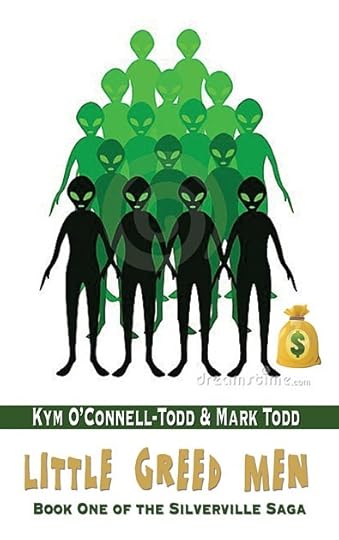 "invasion"
"invasion"
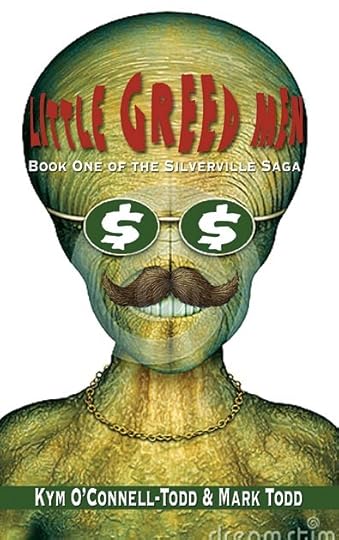 "in your face"
"in your face"
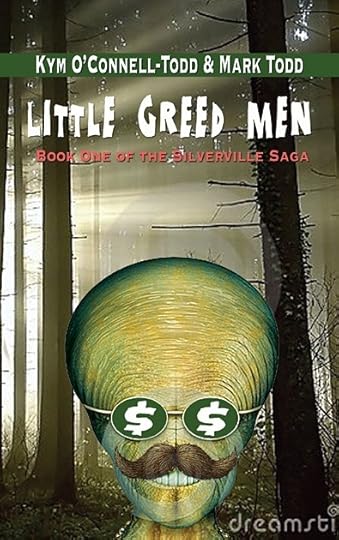 "out of the woods"
"out of the woods"
(And a hat tip to Kym, who created the cover designs for the publisher!)
But we're now in the process of choosing that new cover, one with attitude, to match the attitude of the new title, Little Greed Men.
Raspberry Creek Books has agreed with us that Silverville fans (and friends) should have a say in this. And the publisher has narrowed our choice of the mock-ups to three candidates, and now we want your input.
You can "vote" by
Commenting under this posting (if you don't follow us, it's easy -- just click on the "Follow Us" button in the nav bar on the right, follow the instructions, and then post your comment-vote), or byVisiting our Facebook Page for Write in the Thick of Things, or byVisiting Raspberry Creek Press's blog and Facebook sites. In fact, vote, and vote often, and on all the sites, to show you care!Polling closes in seven days, midnight (Mountain Time) on March 11.
Below are the candidates:
"Invasion""In your face""Out of the woods"
 "invasion"
"invasion" "in your face"
"in your face" "out of the woods"
"out of the woods"(And a hat tip to Kym, who created the cover designs for the publisher!)
Published on March 05, 2013 15:50



